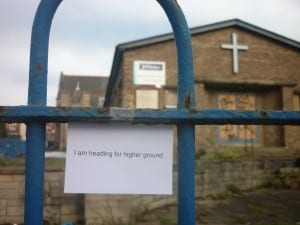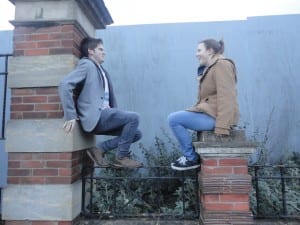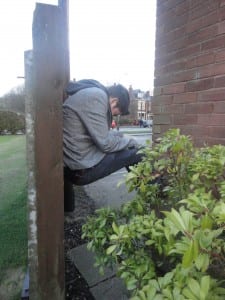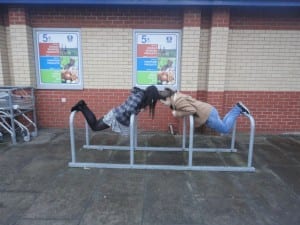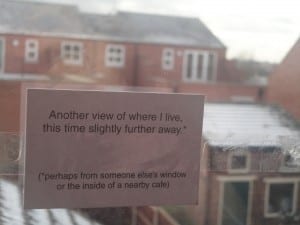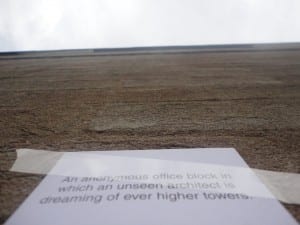In trying to find a places in which to leave my cards for our task this week, I decided to head into town. I went the back way from my house which leads me through the residential streets, past the houses that are all mainly inhabited by students. While my intention was to go all the way to town i got distracted by the surrounding area near where i live. The church in the picture is something ive seen before but never really looked at. Ive wondered why its abandoned? How long has it been like that? What will happen to it? I put the card on it because i felt that it said something more about the state of faith nowadays. If society can let a place of worship fall into decay, then whats happened to the people that used it as a place of solace, a place to rise to higher ground, have they fallen into decay too? Have they lost their sense of purpose as well as their place in faith?
Month: February 2013
Being a Part of the Drift.
Kastner and Wallis’s typology of land art (1998) suggests involvement: “the artist in a one-to-one relationship with the land, using his or her body in forms of ritual practise” (Pearson 2010, p. 33).
During our last session we drifted in small groups, and we took this opportunity to become a part of the architecture physically. We tried to play around and find shapes and spaces that our bodies could reproduce or fit into. As Willi Dorner stated that to“see the space you also have to feel the space. Feel closer to the city. Closer to where you come from” (2005). From this we were able to become a part of the landscape around us, be physically in touch with the architecture that has been built over the years. Then we carried out a free writing task, in which we wrote down any thoughts or feelings that were going through our minds at the time of being a part of the spaces we chose. It led us to ask each other questions about how we felt, such as: what colour did you feel you were? What animal are you? If we chose the colour black and an animal such as a mole, it would suggest that in this space the person would feel rather trapped, scared perhaps and buried in this space. However if blue and a bird was chosen it would suggest that being in the space would have made the person feel exposed, cold and able to get free if wanted to. There is a very big difference between them. This task helped us to understand and become closer to the space around us.
The other task we were presented with was to take the two cards you were given and place them around the city according to what is said on the cards, and document it.
The first one said I was to place it in ‘another view of where I live, this time slightly further away’, so I chose to place it from another room in my house. It was one of my housemate’s windows who has a slightly different view that I have from my own window. I chose to place is there in the hopes that when he comes home he will see the card and look out hopefully examining the view more thoroughly than before.
The second card said to place it on ‘an anonymous office block in which an unseen architect is dreaming of even higher towers’, so after a long journey around the city of Lincoln I found an office block, nothing out of the ordinary, just a plain simple building. It is situated next to Lincoln’s City Hall. Perhaps a person who passes by will read the card, look up and study the building, and wonder the many possibilities that this building may become in the following years.
Work Cited
Pearson, Mike (2010) Site Specific Performance, Palgrave Macmillan.
A Travellers Tale
Since being introduced to the concept of drifting , I have done a lot of it, especially at night because my senses are more alert and hidden aspects of things you wouldn’t normally see can be spotted.
I observed people’s style of walk , finding that there were so many different walking styles. Some people walked on an angle taking small steps indicating a nervousness and urge to escape from the situation. Others took huge strides, leading straight forwards, implying they knew where they were heading, and nothing was going to stop this. I did notice that people on their own tended to walk a lot quicker . This was further emphasized for any hooded characters, suggesting that they want to be hidden from society too. Only a few walked with purpose but in a relaxed manner.
I needed to experiment with the touch of different surfaces. I went up to Lucy Tower and found the concrete surface left sediment after being trod on. After the recent snowy weather, the grit on the road also stuck to my shoes and littered the area. The uneven brick ground along the Brayford was slippery.
When walking at different paces, certain senses are definitely heightened When walking at a slow pace , the truck seams to grind to a halt. Depending on how fast I walk, the water levels seem to change too. Even the wind , when walking fast is audible and the lights in the car park seem to blend together. Finally, when observing a picture above Lincoln Theatre Royal the picture, when moving steadily, seems to move to the same rhythm as my footsteps.
Any watery surface distorts a reflection like a house of mirrors as does my reflection in a rainy car window. When I touch smooth objects , my overall feeling is one of happiness, though if I feel something rigid I feel more alert. I could feel the uneven cobble through the soles of my shoes. Furthermore, I found that habitats could be anything , the sky is a habitat for clouds and the bin a habitat for rubbish. When trying to imagine at the cathedral that I am on Table Top Mountain I can envisage the peaks and even though it was a cold night, I started to feel warmth through my jacket so the image had a lasting impression on my senses.
It was time to head back home, but more drifts will follow, and probably during the day to capture a different experience My sense , emotions and imagination helped me to realize that “memory is a part of everyday experience (Nora, 1992, p1). Site specific performance becomes all the more interesting when that memory is lodged so that a traveller’s tale is perused “when someone goes on a trip he has something to tell about ” (Benjamin, 1992, p84).
Work Cited
Pearson, Mike (2010) Site Specific Performance, London: Palgrave Macmillan.
